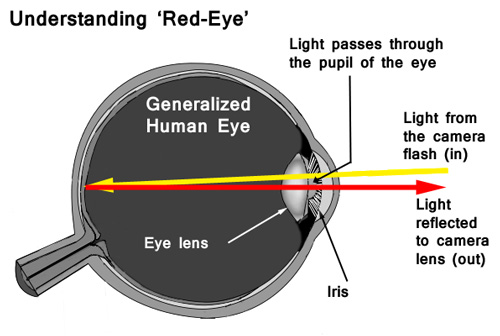![]()
Red-Eye Effect; Red Eye; Red-Eye

Light entering the eye at a small angle is reflected back out to the camera lens. The light is coloured by the pigment and blood vessels on the back of the eye (called the retina).
The problem is usually caused by a camera flash or other bright light-source. The source creates a light beam almost parallel with, and close to, the optical path of the camera lens. The light entering the eye is reflected off the back of the eye (called the retina) then directly into the lens of the camera. The red colour and blood vessels on the retina give the light its red colour. This colour is recorded by the camera.
The red-eye effect is readily created with point-and-shoot cameras and with pop-up flash on DSLRs. These often have a flash very close to the lens creating a direct beam into the eye and reflecting straight back into the lens. The angle between the two beams of light is very small. The effect can occur (less frequently) with other cameras or light set ups.
Red eye is easily removed by post processing software- You will need to check the help files for your image editor to see how to do it. Some cameras also detect it and can be set to remove it. The software technology for auto-removal of red-eye is still developing.
The red-eye effect is sometimes confused with the closely related eye-shine effect. However, the eyeshine effect is caused by reflection from a special membrane normally only found in nocturnal hunting birds and animals and also in fishes.
Definition: Source; Light source
The Red-Eye Effect – information, remedy and tips.
Definition: Red-Eye Effect; Red Eye; Red-Eye
Definition: Eyeshine Effect
Off-camera flash
Does pop-up flash ruin your shots?
Light and Lighting (general light related links)
